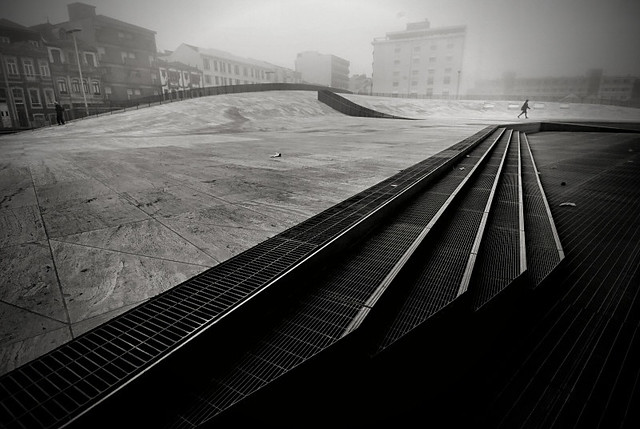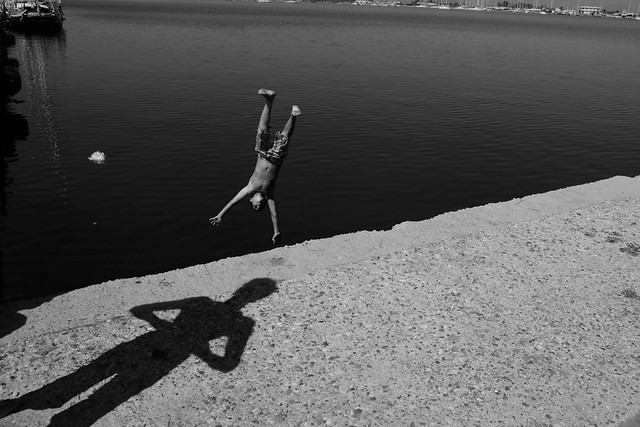Bangkok-based photographer Phatsakorn Bundasak has carved a unique niche in the world of contemporary street photography. What began in 2019 as a simple hobby outside his work as a graphic designer at an advertising agency has grown into a remarkable exploration Black-and-white street photography has always carried a unique power—stripped of color, it sharpens our focus on lines, light, shadows, and the raw geometry of everyday life. The absence of distraction allows the artistry of composition to step forward, guiding the eye to moments that feel timeless and profoundly human. In 30 Striking Black-and-White Street Photos That Master the Art of Composition, we witness how simplicity can be transformed into pure visual poetry.

Photo by: Moises Levy
Each photograph in this collection highlights how framing, balance, and perspective can tell a story. A passerby caught mid-stride, a shadow stretching across cobblestone streets, or the delicate symmetry of urban architecture becomes more than just documentation—it becomes art. These images reveal how strong composition defines the emotional weight of a scene, whether through leading lines that pull us inward or contrasts that create tension and drama.
Street photography thrives on spontaneity, but behind each image lies the photographer’s sharp eye for form and structure. The rhythm of repeating patterns, the placement of subjects within the frame, and the careful play between light and darkness all showcase mastery of visual storytelling. What might seem like an ordinary moment is transformed into something extraordinary when viewed through the lens of composition.
These 30 photographs remind us that black-and-white imagery has an enduring ability to distill life into its purest elements. By focusing on shape, tone, and arrangement, they capture the soul of the street while celebrating photography as an art form rooted in design. For anyone passionate about urban photography, this collection serves as both inspiration and a masterclass in how composition elevates fleeting moments into timeless works of art.
Scroll down and enjoy yourself. All photos are linked and lead to the sources from which they were taken. Please feel free to explore further works of these photographers on their collections or their personal sites.
#1

Photo by: Rohit Vohra
#2

Photo by: Rohit Vohra
#3

Photo by: Rohit Vohra
Use Leading Lines to Guide the Viewer’s Eye
In black-and-white street photography, leading lines become powerful tools for composition. Without the distraction of color, lines in the environment—such as sidewalks, fences, shadows, or even the edge of a building—stand out more prominently. They naturally draw the viewer’s eye toward the subject or deeper into the frame, creating a sense of flow and movement.
When photographing streets, look for elements like tram tracks, staircases, or bridges that can act as guides. Leading lines not only add depth but also help emphasize storytelling, pulling the audience toward the emotion or action within the frame. In monochrome, this technique heightens drama and gives an otherwise chaotic street scene a sense of harmony and order.
#4

Photo by: Rohit Vohra
#5

Photo by: Rohit Vohra
#6

Photo by: Luke Takayama
#7

Photo by: Luke Takayama
#8

Photo by: Luke Takayama
Embrace Shadows and Contrast for Drama
Black-and-white photography thrives on tonal contrast. Shadows, highlights, and mid-tones shape the mood and rhythm of a street scene. By embracing strong contrasts, photographers can inject a sense of drama into everyday life. Look for situations where light carves out shapes—like a person walking through a shaft of sunlight, or silhouettes cast against textured walls.
High-contrast compositions bring energy and intensity, while subtle gradations of gray can evoke quiet, reflective moods. Street photography offers countless opportunities to experiment: harsh midday light, soft morning tones, or the mystery of night. When you consciously use contrast and shadows, you transform ordinary urban moments into striking visual statements that emphasize both structure and human presence.
#9

Photo by: Mary Crnkovic Pilas
#10

Photo by: Mary Crnkovic Pilas
#11

Photo by: Mary Crnkovic Pilas
#12

Photo by: Moises Levy
#13

Photo by: Moises Levy
#14

Photo by: Moises Levy
#15

Photo by: Moises Levy
Pay Attention to Geometry and Symmetry
Cities are full of geometric patterns waiting to be discovered—windows, doors, grids of streets, or repeating architectural motifs. In black-and-white street photography, these patterns take on greater significance because form replaces color as the dominant visual element. Symmetry, whether perfect or imperfect, can be used to create balance within the frame.
For instance, capturing a subject centered under an archway or framed by two buildings enhances the impact of composition. Meanwhile, asymmetry adds tension, keeping the eye moving across the image. By training yourself to see geometry in the environment, you can elevate snapshots into intentional, design-driven works. Geometry provides structure, while the human element layered within those shapes adds the soul of street photography.
#16

Photo by: Moises Levy
#17

Photo by: Marie-Sophie D
#18

Photo by: Marie-Sophie D
#19

Photo by: Marie-Sophie D
#20

Photo by: Marie-Sophie D
Capture Decisive Moments with Intentional Framing
Street photography often relies on timing—the so-called “decisive moment” where subject and setting align perfectly. But beyond pressing the shutter at the right instant, framing plays a crucial role in composition. Black-and-white enhances this because every element stands out with clarity. Use doorways, windows, arches, or even blurred foreground objects to frame your subject in a way that highlights their presence.
Framing helps to isolate the subject from the surrounding chaos of the street while adding depth and dimension to the shot. By patiently observing and anticipating, you can capture a fleeting gesture, an expression, or a motion within a carefully composed frame. This combination of timing and composition transforms candid moments into timeless works of art.
#21

Photo by: Marie-Sophie D
#22
Photo By: Manish Khattry
#23
Photo By: Prashant Godbole
#24
Photo By: Nayeem Siddiquee
#25
Photo Credit: Rui Palha
Simplify the Scene to Focus on Essence
One of the greatest strengths of black-and-white photography is its ability to simplify. By removing color, distractions fade and the core elements of a scene emerge—light, form, and human emotion. In street photography, this minimalism works beautifully. Instead of trying to capture everything, focus on one subject or a single interaction that tells a story.
Cropping out unnecessary clutter or shooting with a wide aperture can help strip the frame to its essentials. Simplification doesn’t mean losing depth; it means highlighting what truly matters. Whether it’s a lone figure crossing a street or a simple silhouette against a bright wall, black-and-white composition allows the viewer to connect more deeply with the story being told.
#26
Photo By: Vineet Vohra
#27
Photo By: Manish Khattry
#28
Photo Credit: Maria Spyropoulou
#29
Photo Credit: Ester
#30
Photo Credit: Georgie Pauwels



















